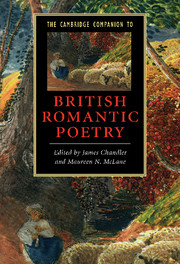Book contents
- Frontmatter
- Introduction: The companionable forms of Romantic poetry
- 1 The living pantheon of poets in 1820: pantheon or canon?
- 2 Romantic poetry and antiquity
- 3 Romantic meter and form
- 4 Romantic poetry and the standardization of English
- 5 Thinking in verse
- 6 Romantic poetry and the romantic novel
- 7 Wordsworth’s great Ode: Romanticism and the progress of poetry
- 8 Romantic poetry, sexuality, gender
- 9 Poetry, peripheries and empire
- 10 Romantic poetry and the science of nostalgia
- 11 Rethinking Romantic poetry and history: lyric resistance, lyric seduction
- 12 The medium of Romantic poetry
- 13 Romantic poets and contemporary poetry
- Index
- Series List
Introduction: The companionable forms of Romantic poetry
Published online by Cambridge University Press: 28 November 2008
- Frontmatter
- Introduction: The companionable forms of Romantic poetry
- 1 The living pantheon of poets in 1820: pantheon or canon?
- 2 Romantic poetry and antiquity
- 3 Romantic meter and form
- 4 Romantic poetry and the standardization of English
- 5 Thinking in verse
- 6 Romantic poetry and the romantic novel
- 7 Wordsworth’s great Ode: Romanticism and the progress of poetry
- 8 Romantic poetry, sexuality, gender
- 9 Poetry, peripheries and empire
- 10 Romantic poetry and the science of nostalgia
- 11 Rethinking Romantic poetry and history: lyric resistance, lyric seduction
- 12 The medium of Romantic poetry
- 13 Romantic poets and contemporary poetry
- Index
- Series List
Summary
Only that film, which fluttered on the grate, Still flutters there, the sole unquiet thing. Methinks, its motion in this hush of nature Gives it dim sympathies with me who live, Making it a companionable form . . .
Coleridge, “Frost at Midnight”It was, most immediately, the work of his own contemporaries that prompted Percy Shelley to proclaim, at the close of his Defence of Poetry (1821), that “Poets are the unacknowledged legislators of the world.” The authority of those poets in the age we have come to call “Romantic,” Shelley explained, derived not from their opinions, with which he often disagreed, but from their capacity to tap into a certain spirit - what he called “the spirit of their age.” Shelley figured this with a metaphor taken from recent developments in the natural sciences: it is impossible to read these contemporaries, he wrote, without being struck by “the electric life that burns in their words.” “Electricity,” for Shelley, is at once a modern scientific discovery and a theme that hearkens back to the ancient myth of Prometheus, the thief of divine fire. The prototypical writer of his age - the “Romantic poet” - thus became on Shelley's account a kind of modern Prometheus, a poet of the electric life of words. This view would not go unchallenged. Indeed, even before it was written down in the Defence of Poetry, Mary Shelley had published Frankenstein: Or, The Modern Prometheus (1818), a fable of “electric life” and monstrous ambition with more than casual application to her husband's grand schemes. In spite of such challenges, or because of them, a sense of verbal electricity in Romantic poetry has persisted through generations of readers and assured these writings a special place in British literature ever since.
- Type
- Chapter
- Information
- Publisher: Cambridge University PressPrint publication year: 2008
- 2
- Cited by



